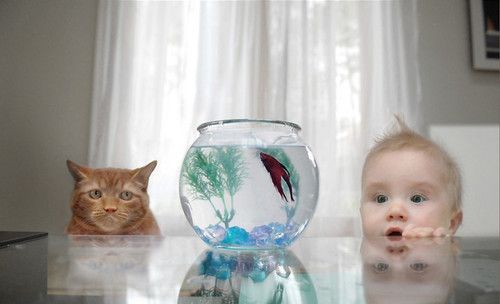Maria Montessori believed that a child's intelligence and knowledge of the world always originate in the senses. Any thought is always preceded by a process of collecting information. This means that the more subtly all the analyzers work, the more chances a person has to solve the problem facing him.
In his book “The Absorbent Mind of the Child,” M. Montessori says that sensory development allows you to open up a whole new world for the baby, making more things and their properties visible, as if someone suddenly turned on the light in a dark room.
It is important to understand that what adults consider obvious, a child has yet to learn: a small stone is lighter than a large stone, but at the same time heavier than a feather, glass is smooth and cold to the touch, and an autumn leaf is warm and rough. A child's absorbent mind is wired for learning, but it is important to place the child in the right environment where he can put his natural curiosity to use.
For more information about Maria Montessori's approach, watch our webinar for parents:
History of Sensory Education in Montessori
Maria Montessori was not the first teacher to draw attention to the importance of developing children's senses. When developing her approach, she relied heavily on the work of the French physician and teacher Edouard Seguin, who at one time worked with children with special needs and created his own system of exercises for developing children’s perceptions and teaching them everyday skills. Jean-Jacques Rousseau and Johann Heinrich Pestalozzi in their works also paid attention to the role of the development of sensory organs in children's learning.
Robert Baden-Powell, founder of the Scout movement and contemporary of Maria Montessori, said that to gain knowledge about the world, children need real experience of interacting with objects. This statement formed the basis of his theory of active learning. He highly valued Maria Montessori's pedagogical approach, noting that if teachers stop commanding and begin to more delicately reinforce a young child's natural need for new experiences, teachers can create a much more solid basis for subsequent learning and development. In his opinion, the idea of education as hard and exhausting work is hopelessly outdated.
Maria Montessori herself began her career working with special needs children who were deprived of adequate sensory stimulation: they had almost no toys, and their whole life was reduced to a series of basic caregiving activities. She was able to clearly prove that changing the living conditions of children significantly changes the level of their abilities. Today, the influence of the environment on a child’s development has been proven at the neurophysiological level. We recommend reading John Medin's book, Rules for Your Child's Brain Development, to become more familiar with this topic.
Maria Montessori created a system of sensory education based on many years of experience observing children and studying the works of outstanding teachers and doctors. Although she was not the first to discover the need for sensory experiences in child development, she was certainly the first educator who was able to draw public attention to this fact.
What is sensory development in children
For the full upbringing of children, sensory development plays one of the most important roles. It is based on the formation of perceptions and ideas about the form and properties of objects. Sensory development plays an important role in early preschool age. It helps to create a general picture of the world around him in the baby’s head.
Beginning of sensory perception
What is this in pedagogy, definition
In pedagogy, sensory education is the development of sensations, ideas and perceptions. This is not only about introducing the baby to all the functions, but also about their targeted improvement.
Why is it so important for children
Sensory development of young children is activities that are based on the assimilation of the properties of an object. This is what underlies the development of mental abilities. Further learning depends on how correctly sensory education is structured at an early stage.
On a note! Children master and study the shapes of objects, materials, and phenomena naturally while playing, looking at pictures, or listening to music. If at this moment no help is provided from adults, then the perception will be the same as the baby’s. Most often, this leads to the fact that perception remains incomplete.
That is why it is very important that adults have control and help. It should consist of explaining the diversity of the surrounding world, replenishing the vocabulary to describe the properties of phenomena and objects.
Sensory education according to the Federal State Educational Standard should be organized in a multi-stage manner. The task of the learning process is to form certain standards in children. It is important to do everything correctly, as this is necessary for further teaching activities and children’s competent perception of new information.
It is important that the baby can not only distinguish and identify objects by their properties, but also be able to apply this knowledge to other objects. For example, the mathematical standard of shapes is the ability to identify the simplest shapes.
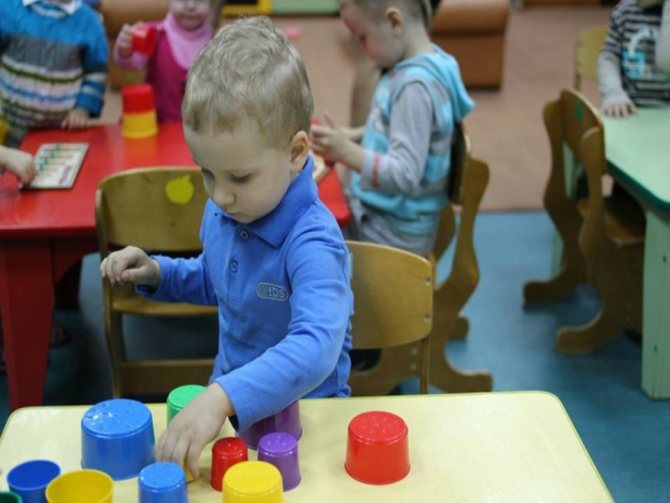
Mastering the properties of objects
What is the basis of sensory education?
The basis of sensory education is the joint activity of children with teachers. Game and practical situations allow you to accumulate and generalize knowledge. Practical activities include the following:
- working with a variety of materials;
- drawing with paints, crayons, pencils;
- modeling;
- reading stories and fairy tales;
- study of painting;
- design;
- motor activity.
For preschoolers, work activity plays an important role. During labor, the child develops a system of knowledge about tools, forms of labor, and methods of execution.
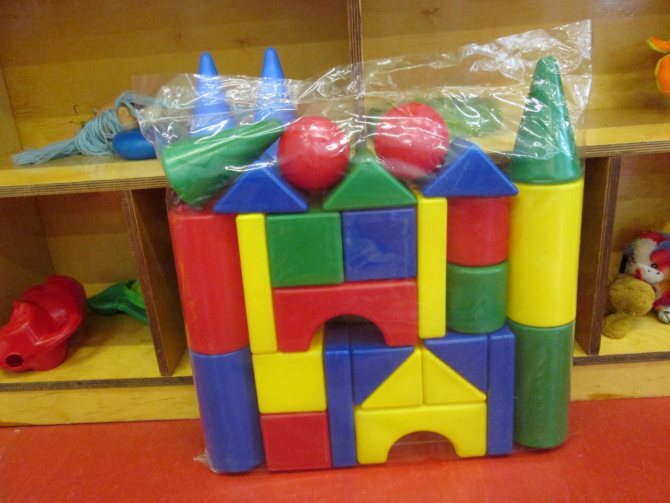
Construction as a means of sensory education
Sensory development tasks
The goal of sensory education for children is to enrich their sensory perception. On this basis, the following tasks are set:
- formation of various actions for examination;
- creation of sensory standards, the ability to generalize ideas about properties;
- teach children to denote objects in one word.
On a note! For each activity there must be integrity of perception and representation.
Rules for organizing sensory education according to Montessori
Maria Montessori noticed that at a certain age, children's behavior and motivation are very similar. For example, in the first three years a child is especially sensitive to order. This childish “pedantry” is necessary for the child to create a stable image of this world. It can also be used to develop a child’s natural need for knowledge by creating tasks that are exciting for a certain age, which would help the child master the most important qualities of objects: color, size, shape, material.
As Maria Montessori herself admitted, the work of creating the sets was not easy: it was necessary to create material that would demonstrate properties in isolation, have pedagogical value, and at the same time be attractive to the child. This is how a set of Montessori sensory material appeared.
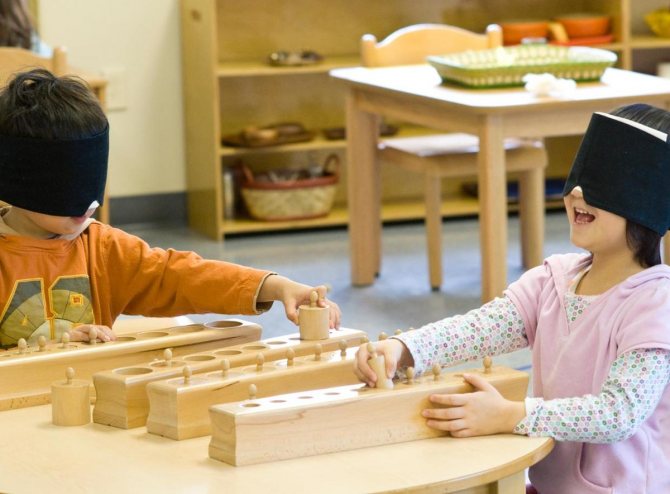
The main objectives of Montessori sensory exercises
- Teach the baby to perceive, compare and classify sensory experiences of different modalities,
- Expand the child’s sensory experience, teach him to notice even small differences, develop the child’s senses as much as possible,
- Teach your child to use his own memory: “I remember what yellow is, and I can always imagine it in my head,”
- Teach to critically evaluate any information and develop the habit of striving for maximum accuracy when gaining knowledge about the world,
- Create a basis for the emergence of abstract thinking and imagination.
Let us explain with an example how sensory and abstract thinking are connected:
Let's say you've never seen an okapi. Now your task is to imagine this animal by description: it is a bay horse with the legs of a zebra and the head of a giraffe. Happened? If so, congratulations, your sensory development is on point, because for this exercise you need to have an understanding of the colors of horses, the coloring of a zebra and the body structure of a giraffe.
Any abstract idea is essentially a clever interweaving of various information from our real experience. That is why a child’s intelligence begins in early childhood and the ability to exercise all the senses over and over again.
What can you find in the sensory development area of the Montessori center?
Visual information
- Shapes: sets of geometric shapes, as well as more complex shapes (for example, animal figures or plant leaves)
- Volumetric figures: Pink Tower, Brown staircase, Red barbells, Montessori weight cylinders
- Colors: sets of basic colors, card index of shades
Tactile information
- Texture: palpable board, rough tablets, baskets with rags
- Temperature: heat jugs, heat plates
- Weight: weighing cylinders and plates
Stereognostics
- Sorting small items, magic bag
Audio information
- Volume: sound boxes, musical accompaniment of classes
- Height: bells, sound cylinders, musical instruments

Taste and smell
- Taste bottles, conversations during meals
- Jars with scents
In addition to exercises with isolated sensory qualities, in a Montessori space you can always find sets that combine several qualities, such as color and shape:
- Binomial cube
- Trinomial cube
- Constructive triangles
- Montessori squares
- Cylinders without handle
The study of sciences according to M. Montessori also begins with sensory education. Acquaintance with the basic qualities of objects of the natural and cultural world prepares the child for studying social sciences, biology, physics, chemistry and even mathematics:
- Sets of leaves of different plants
- Thematic puzzles
- Maps and globe
- Flags
- Sets with natural materials
- Reproductions of artists and nature photographs
Sensory education of children in kindergarten
Svetlana Ivanova
Sensory education of children in kindergarten
sensory development is the development of his perception and the formation of ideas about the external properties of objects: their shape, color, size.
The importance of sensory development in early and preschool childhood is difficult to overestimate . It is this age that is most favorable for improving the functioning of the senses and accumulating ideas about the world around us.
The problem of sensory development and education of children has always been the focus of attention of Russian psychologists and teachers. I.M. Sechenov argued that “the essence of mental development lies in the ability of the senses to perceive external influences in the form of sensations, to analyze the latter in time and space.” This means that a person’s mental life largely depends education of the perceptive
The idea of I. M. Sechenov is revealed in the works of K. D. Ushinsky. In the essay “Man as a Subject of Education ”
the special importance of early
sensory development .
Emphasizing the close relationship between the sensory of sensory education developed by M. Manaseina includes recommendations for the preservation and development of the organs of vision, hearing, touch, smell, taste. She attached considerable importance to productive activities (drawing, modeling, etc.)
.
M. Montessori also paid great attention to sensory education . She believed that sensory skills are the basis of intellectual development.
Outstanding foreign scientists in the field of preschool pedagogy (F. Frebel, O. Decroli, as well as well-known representatives of domestic preschool psychology pedagogy (E. Tikheyeva, L. V. Zaporozhets, A. P. Usova, N. P. Sakulina, etc.)
they rightly believed that
sensory education is one of the main aspects of preschool education .
Sensory development on the one hand forms the foundation of the general mental development of the child, on the other hand it has independent significance, since full perception is necessary for the successful education of the child in kindergarten , at school and for many types of work.
Of great importance in sensory education is the formation in children of ideas about sensory standards - generally accepted examples of the external properties of objects. The sensory standards in the field perception are the chromatic colors of the spectrum. Geometric shapes serve as standards of form. Familiarization with them differs from studying these figures in the process of forming elementary mathematical concepts. Mastering shapes involves becoming familiar with squares, triangles, circles, rectangles, and ovals.
A trapezoid may be inserted later. In all cases, this means the ability to recognize the corresponding figure, name it and act with it.
Ideas about the relationships in size between objects act as standards of size. As well as highlighting different dimensions of size - length, width, height, thickness.
Currently, issues of sensory education are dealt with by L. A. Wenger, E. G. Pilyugina, N. A. Mikhailenko and others. JI.A. Wenger in the book “ Raising a child’s sensory culture ”
offers a consistent, systematic introduction of the child to
sensory standards . This manual deals with the education of children's sensory culture in the field of perception of shape , size, and color. But the visual perception of the space of spatial relationships is no less important.
Later I studied the author’s “Development”
, section
“
sensory education ” , which was published in the magazine
“Preschool
Education ” for 1994 No. 2.
The authors argue that sensory development should occupy a central place in working with children. In addition, I got acquainted with the work of teachers at kindergarten No. 66 .
Moscow A.V. Kolyadina and G.N Nechaeva, who used in their work a specially designed cycle of classes for younger preschoolers. I completely agree with the authors of the “Development”
and I support the opinion of teachers and psychologists about
sensory education of children , that familiarization with sensory standards should be consistent and it should occupy one of the leading places in working with children.
Work on sensory education began with examining each child for knowledge of color and shape. Based on the results of the survey, I additionally introduced into the network of classes a lesson on sensory education , the purpose of which is to introduce children to basic geometric shapes, teach them to distinguish colors and compare objects according to several characteristics.
Each lesson was aimed at introducing children to one or two colors, shapes and measurements of size. Some children remembering colors. For example, Styopa M. could not remember the color red, and Ilya V. could not remember the color green. This really hindered them in such classes as drawing, appliqué, and modeling. When the children were drawing grass, Pasha constantly asked what color it was, where was the green? As a result, he was distracted himself and distracted other children , did not have time, and did not draw well. Didactic games came to our aid. I used didactic games both in class and in my free time.
1. “What is green?”
(The children came up with ideas and remembered what could be green - cucumber, crocodile, grass, leaves, etc.)
2. "Choose by color"
.
3. “Guess who this is about?”
(I described the clothes of one of the children, and the children had to guess who I was talking about.)
We could objectify some colors. For example: yellow - lemon, orange - orange, etc. So we got acquainted with the six colors of the spectrum: red, orange, yellow, green, blue, white and their names.
In parallel with color, I introduced the children to geometric shapes. In the first lesson, I consolidated the children's knowledge about circles and squares . By comparing them, it was easier for children to identify their main differences. A circle is round, it can roll, it has no corners. But a square cannot roll; it has four corners and all sides are equal. Each child had handouts. All children could examine them with their own hands and conduct tests. All this helped to consolidate children’s knowledge about circles and squares . Then we moved on to studying triangles and ovals. Using the same methods: comparison and examination, children easily and quickly mastered geometric shapes. If the children found the oval easy, it was completely different with the rectangle. Comparing it with a square, we identified its main properties (two sides are short, two are long, and also found how they are similar (both a square and a rectangle have four corners)
.
Together with the children we figured out what a rectangle looks like. Children compared it to a board, pencil case, ruler, etc. And yet the rectangle was difficult to remember. It seems to me that the children were frightened by this unpronounceable word. If the child could not pronounce this word, rectangle, then he blushed, became withdrawn and embarrassed. Therefore, I tried not to put pressure on the children , I did not demand this particular name
the children It was important for me that the child, pointing to a rectangle, did not say that it was a square, but objectified it (i.e., called it a board)
.
This means that the child had some kind of concept. At the same lessons, she taught children to compare objects by size using different techniques (application, superimposition)
.
Formed children's ideas about length , width, height.
She paid special attention to the development of her eye. When introducing children to sensory standards, we must not forget about the formation of speech skills. When at the beginning of my work I examined each child, I was faced with the fact that the child knew this color or shape by eye, but could not name it. For example, when I asked Dima K. to show the color red, he showed it. But when I changed the form of the task and asked him to name what color it was, he was silent. Therefore, I paid a lot of attention to the formation of speech skills.
In the first lessons, I discussed all my actions in detail, commented on the children’s , evaluated the results of their work, and asked questions to involve them in the description of objects and actions performed with them. Gradually, the children developed a need to explain their actions themselves and evaluate what happened. For the same purpose, I introduced a new rule for didactic games. The child had to discuss each action. For example: the game “Geometric Dominoes”
.
When the child placed a domino, he had to say why he placed it here and name the color and shape of the figure. Our children really loved the classes on sensory development and even played with various educational games in their free time. All material used in classes is stored in a specially designated place and is available at any time. I believe that didactic games and exercises, along with activities, are the main means of sensory education . In classes based on the direct teaching influence of an adult, it is impossible to accomplish all the tasks of sensory education . I used didactic games widely in everyday life, during hours of independent play activity. At first, I offered children games that influenced the development of one sensory standard . For example: “Match by color
,
“Match by shape
,
“Hide the mouse
.
Then she offered games that affected several sensory standards . For example: “Geometric domino”
(color and shape),
“Rainbow”
(differing in color, shape)
were made , size) .Together with the children we came up with a series of games on flannelgraph. These are:
“Lay out a pattern”
,
“Collect a picture”
,
“Circles and corners”
, and many other games.
Having mastered sensory standards , children began to perform better in all other activities. This was especially noticeable in art and design classes. In drawings, modeling, and appliqué, children began to better convey such characteristic external features of objects as shape, size, structure, and color. The drawings became brighter, the children learned to create images in which the appearance of the object became recognizable to children and adults.
Children stopped saying “I can’t”
,
"I can not"
. Fear and constraint in classes disappeared.
During classes on getting to know the environment and nature, children began to look at the pictures with interest and describe them. The children's vocabulary has expanded and enriched . Knowledge of color helped children learn the rules of the road, how traffic lights work, and various road signs.
Children 's aesthetic perception . Children began to see the beauty of their clothes, an interest in bright clothes and decorating tables with flowers appeared. The world of simple things began to be perceived as wonderful and beautiful.
In the middle group I continued to work on sensory development . This group no longer had separate classes on sensory development . This work was carried out as part of art and mathematics classes, as well as in the form of didactic games and exercises in free time.
Children their relationships, learn the possibility of obtaining certain colors by mixing, and highlight the color blue.
Here we were helped by such games and exercises as “Coloring the water”
,
“Developing observation skills”
.
She continued her work to consolidate children’s knowledge about 5 shapes , especially the rectangle, and introduced the children to a new shape - a rhombus. The children themselves chose this figure to study and began to invent and remember what it looked like (embroidery patterns)
. For my part, I suggested that the children also get acquainted with quadrilaterals and varieties of triangles. She paid much attention to tasks on making figures independently, dividing figures into parts and obtaining new ones. As well as composing geometric figures from other figures:
Since the middle group masters working with scissors, almost every math or arts lesson included working with scissors.
Working with scissors continued in my free time (cutting napkins into 4 parts)
.
Continued work to familiarize children with three-dimensional bodies . In addition to the ball and cube, the children learned about the cylinder and the cone. She paid special attention to didactic games and exercises. For example, the game “fold a square”
,
“geometric dominoes”
, exercises:
“rectangles”
, and exercises to develop
the perception of triangles . To develop the perception of geometric shapes, you can use the following games: put together a shape from sticks. Children really like the game “frames and inserts”
.
This game develops children in several directions:
1) develops the ability to recognize and distinguish the shape of flat figures and their position on the plane (visually and by touch)
;
2) prepares children to master writing and drawing;
3) introduces geometric terminologies - names of figures.
This game can be played from an early age and continued to be played in all other groups, gradually increasing its difficulty.
In the middle group, I also offered the children the game “Cut”
.The purpose of the game: to teach
children to find out what shape will result from a cut made in a square folded in four. It is necessary to guess from the proposed quarter of a square with a cutout what the square will be like, that is, mentally “unfold”
the square.
I found this game in the magazine “Preschool
Education ” 1994, No. 11, where it was proposed to be carried out as an activity.
Gradually, by the end of the year, the children and I moved on to creative games that require ingenuity, ingenuity, and teach modeling.
By the end of the middle group, 90% of the children had mastered all the proposed geometric shapes, primary colors and their shades and signs of size. In the older group, the possibilities for sensory education increase significantly. In class I continued to solve programming problems. This group used different types of didactic games and exercises. Games with rules came first. Children 's interest in printed board games "Seasons"
and etc.
Word games have become very important: “Guess what object this can be said about”
,
"Say the opposite"
;
verbal and active games, as well as games and exercises to develop the eye and coordination of movements; puzzle games, various puzzles that we took from children's magazines “Murzilka”
,
“Funny Pictures”
.
The complication of games occurs both in terms of sensory tasks and in children mastering more complex game actions. In games, children consolidate their ideas about the variety of properties of objects and phenomena of the surrounding reality, and use sensory standards as a measure of specific properties of objects and phenomena.
She paid much attention to games that prepared children for school, taught them to model, games to develop logical thinking, ingenuity, ingenuity, and develop fantasy and imagination.
I used competition games “Who knows and can do more”
, game
"School"
.
I paid a lot of attention to games to draw up a plan. The game was called “Make a Plan”
.
She also conducted classes “Toy Exhibition”
,
“Fashion Show”
and classes using the
“Triz”
.
So in one lesson, together with the children, using the method of focal objects (MFO),
came up with a new sun
(iron, square, silver-black)
.
I also used the games “On the contrary”
,
“Good and bad”
.
Knowledge of sensory standards will help children in mastering many subjects at school. Of the 24 constantly attending kindergarten children entered the six-year-old class . Another 7 could have also passed, but refused for various reasons from their parents or for health reasons. The rest of the children also have good sensory . They didn't go to school just because they weren't old enough or didn't have the perseverance. Agree that the result is not bad. In the future, I would like to start working on sensory education with another group at an early age (from 1.5 years old)
.
Literature:
1. magazines “Preschool education ”
for 1994, JN^2,4,5, 11.
2. L. F. Tikhomirova children’s cognitive abilities ”
.
3. Nikitina “Educational games”
.
4. N. N. Podyakova, V. N. Avanesova “ Sensory education in kindergarten ”
.
5. L. A. Wenger, E. G. Pilyugina, N. B. Wenger “ Raising a child’s sensory culture ”
.
Montessori Sensory Development Ideas at Home
Despite the fact that Montessori centers use specialized kits for the development of children, it is not difficult to create a game that enriches a child’s sensory experience.
- Animal competitions. Discuss with your child how different animals move and try to organize a competition: draw a start and finish line and ask them to run sideways like a crab, hobble like a bear, or jump like a hare.
- Modeling. Kinetic sand, salt dough, plasticine and clay perfectly develop a child's tactile sensitivity. You don’t have to try to create a masterpiece right away: just learn how to roll balls, flatten them into pancakes, stretch them into sausages, squeeze them and watch how the material seeps through your fingers
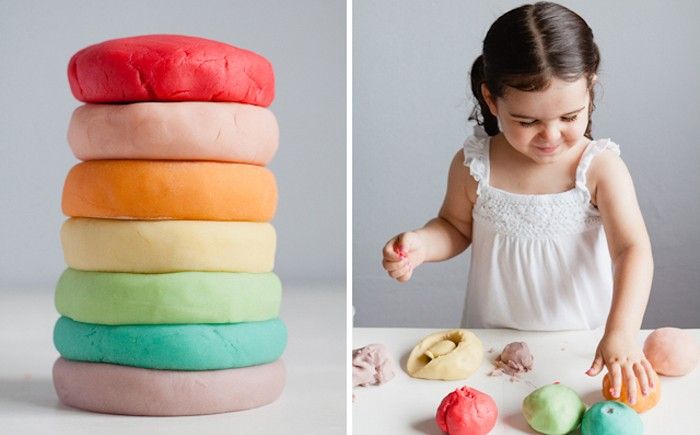
- Draw with crayons on the pavement and play hopscotch. Like the previous exercise, this trains not only the senses, but also the child’s coordination.
- Game of silence. Is it just not interesting to remain silent anymore? Invite your child to remember 5 different sounds that he heard during a minute of silence (car horn, bird sounds, people talking, a dropped pencil, etc.)
- Treasure hunt. Draw a list of objects that your child should find during your next walk (a long rough pine cone, a red leaf, a yellow leaf, a dry branch, etc.). Don't forget to take a pen with you to cross out what you find.
- Drawing with stamps, fingers, brushes and even cotton swabs. It is difficult to overestimate the impact of free creative activities on a child’s development.
- Guess the smell. Place items with different scents in opaque boxes: your favorite shampoo, orange peel, a little vanilla, dried cloves, fried cutlet. Organize a competition for the keenest sense of smell.
- Experiment with musical instruments: xylophone, glucophone, kalimba, drum, tambourine, shaker, pipe. It is not necessary to immediately enroll in a music school to introduce your child to music.
- Guess the product by taste. Blindfold your child and ask him to guess what's for lunch today.
- Let your child walk barefoot more often, because there is a whole world under his feet: sand, lawn, stream, pebbles.
Sensory development of preschool children (4-5 years old)
In middle age, preschoolers begin to experience role-playing interactions in play. During play activities, children begin to realize that everything happens for the sake of the meaning of the game. This allows for the active development of visual activity. A special role is given to drawing. It becomes objective.
For example, a child at this age must realize that a person has eyes, a mouth, a nose, hair, fingers, and elements of clothing. There is an improvement in visual activities.
On a note! Children begin to draw shapes on their own, understanding their purpose, and master the skills of cutting with scissors and gluing parts. The concept of design is introduced.
The basics of sensory education for middle-aged children also include the following:
- Developing the skills to create buildings according to your own ideas.
- Development of both gross and fine motor skills.
- Particular attention is paid to the coordination of movements and dexterity of the child. He must have good balance, step over obstacles, and be able to play with the ball.
- Perception becomes more developed. Children should be able not only to recognize geometric shapes, but also to understand what objects are similar to them.
- The concepts of size, color, length and width are well developed.
- Orientation in space has been improved.
- Preschool children's memory capacity increases. They can remember eight names of objects. Voluntary memorization is formed. The child is already able to understand the task assigned to him, they remember the instructions given to them by their parents or educators.
- There is an active development of imaginative thinking. You can use schematic images to solve the problem assigned to you.
- Children can come up with a short fairy tale or story on their own. Awareness of the interaction of events develops.
- Attention becomes more stable. A child of four years old can already concentrate on one task for more than 15 minutes. When performing an action, he can remember the condition that must be met.
- Diction and pronunciation of sounds improves. Speech in children becomes more developed. At this age, speech disturbances that were previously observed may be corrected. The development of the grammatical aspect is progressing well.
- The child’s communication with adults changes significantly. It becomes more educational in nature. The child is increasingly interested in information that is difficult for him.
- From the age of 4 to 5 years, the need for respect from adults plays a major role in development. It is very important that parents and educators give praise.
Theme for drawing “Defender of the Fatherland Day” in the middle groups of preschool educational institutions
Sensory development at this age is also reflected in relationships between peers. Selectivity appears, children are divided into separate groups. Leadership begins to emerge. Competitiveness is important for the development of a child’s own image.
Important! It is necessary to direct the development of middle-aged children in the right direction. Help them form the correct idea of their image, take a position among their peers in the group!

Development in drawing
Sensory development of children aged 5 years and older
At the age of five, the most critical age begins before preparing for school. Children already clearly know the concepts of shapes, colors, and are able to compare one object with another according to their properties. They have already accumulated significant experience in tactile sensations.
The task of educators and parents is to consolidate existing knowledge. At the age of 5 to 6 years, preschoolers are already able to play intellectual games. This should be actively used in educational activities. For example, you can arrange quizzes after each topic covered.
Chess, checkers and children's lotto are great for this age. This not only trains attentiveness, but also memory and logic. It is best to focus on group games and role-playing activities from the age of five.
On a note! Activities on learning the rules of the road can be used as educational games for preschoolers. Here you can come up with both quizzes and role-playing scenes. This method will help not only to effectively consolidate new material, but also to train sensory skills.
After the age of five, special attention should be paid to the communication abilities of children. This is an important aspect of education for future schoolchildren. To do this, you often need to use group work and collective creativity. The task of educators is to help a preschooler find his place among his peers.
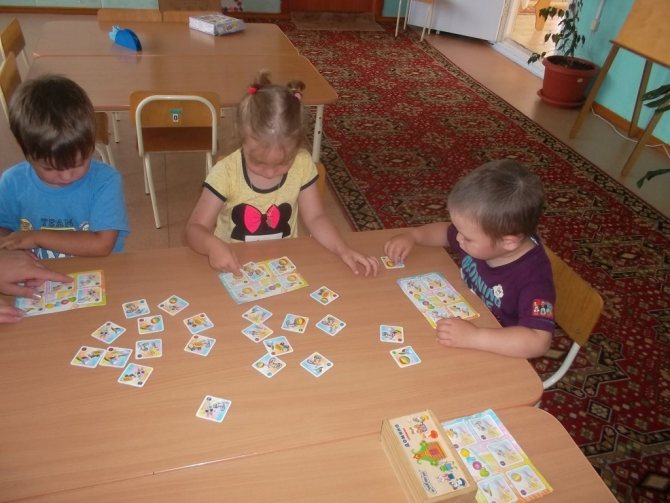
Games for preschoolers
conclusions
The development of a child begins with the development of his senses. In the 21st century, this is not just the opinion of teachers, but a scientifically proven fact. At an early age, it is very important for a child to learn as much as possible about the world around him using all his senses, which is why no computer can replace a child’s real experience of being in a different environment (forest, park, store, kitchen, etc.). Try to introduce your baby to a variety of objects, and think about how to organize a sensory development area for him, if the ideas of Maria Montessori are close to you.
